- info@wildlifeanimalcontrol.com
Call us for help in your town
Wildlife Control Education
How To Get Rid of Squirrels in Attic
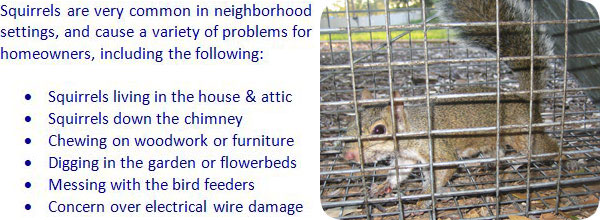
We provide squirrel removal in over 1700 USA locations - serving the whole USA.
It is my goal to educate the public about squirrels and other wildlife, and
provide tips for safe, effective, and responsible wildlife removal.
Summary of Step-By-Step Instructions:
1) If you're simply dealing with squirrels outside, you can prevent chewing by spreading/spraying capsaicin on plants.
2) If you want to trap squirrels outside, set 5" x 5" x 14" cage traps in areas of squirrel activity - often bolted to trees, fences, roof, etc.
3) Bait traps with peanut butter and whole peanuts in shell. Set traps in shade, to prevent squirrels from over-heating.
4) If you have squirrels in the attic, you must inspect the whole house to find out how they are getting inside. Inspect inside the attic as well.
5) Setting traps inside the attic will not work. You must either set traps outside near entry holes, or mount traps directly to entry/exit holes. Or better yet, simply set one-way exclusion doors on the holes, which allow the squirrels a way out, but not back in.
6) Once all squirrels are removed, seal the entry hole(s) with steel, which is unchewable.
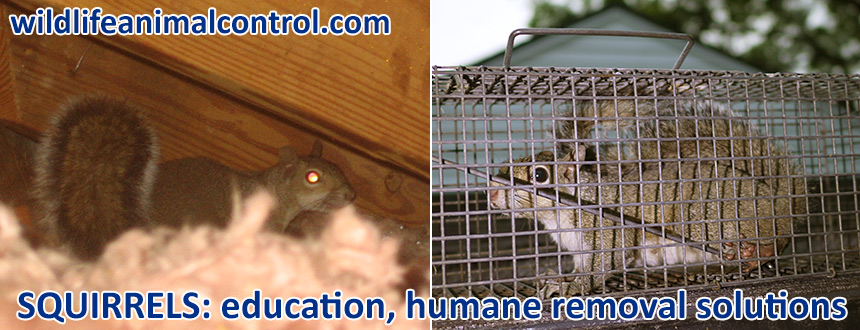
Need squirrel removal in your hometown? We service over 500 USA locations! Click here to hire us in your town and check prices - updated for year 2020.
Squirrels are usually not harmful when they are living in your trees, but they can be very destructive and a health hazard once they invade your home. Squirrels can squeeze through small holes or gaps, or chew their way in, and
will commonly set up their nests in your walls and attic. These critters are attracted to secure and warm places to build their nests and have their young. Squirrels build their nests out of material such as dried twigs and leaves,
scraps of cloth and hair which makes them flammable when they are in your walls. This is especially true considering that squirrels may also chew through your electrical wiring which can start house fires. Squirrels can also die in
hard to reach a place which is unsanitary and leaves a smell that will permeate everything in your house. If you are experiencing problems with squirrels, here are some do-it-yourself tips to get rid of them, humanely but effectively.
Click below photos for squirrel removal examples by the pros:
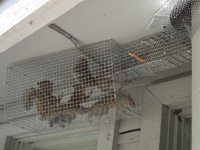 |
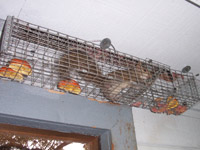 |
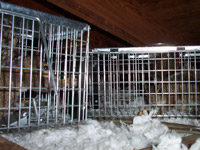 |
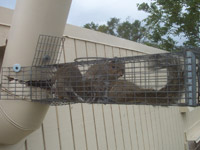 |
- Identify where the squirrels are gaining entry into your house. Squirrels will often make the existing holes in your walls and roof bigger until they can get in. They will also get in your house through ventilation systems. Read about inspect your house to find animal entry holes. Once you have found the places that the squirrels are getting in, you will need to set the correct traps or one-way exclusion doors. But beware! Is it a mother squirrel with a nest of babies inside? This may be the case in August/September or February/March. If you remove the mom and leave the babies inside, you'll have a problem.
- One of the best and most humane ways to remove squirrels from the attic is with the use of one-way doors. Mount these on the entry/exit holes, and when the squirrels go out for food and water, they're merely blocked outside. This won't work if you've left other entry holes open, or if there's wood or screens to chew back in through.
- Trapping squirrels is not an easy task and it is not even legal in some areas. To ensure that you are not breaking the law, simply call down to the local humane society or the fish and game office and ask if you are allowed to trap squirrels on your property. If you are allowed to trap squirrels you can get both lethal and live traps at a hardware store, online, or rent one from the humane society. Bait the trap with something squirrels like such as peanut butter or fruits. However, traps are only a small part of solving a squirrel problem, and getting the correct target squirrels is tricky. It's best to mount traps right on the exit hole to your attic.
- Once you have trapped the squirrels you will need to relocate them no less than 10 to 15 miles away from your house, otherwise they will just come back. Once you have relocated all the squirrels you will then need to go through your home with a keen eye and repair all the holes and vents that they used to get in.
- You will also need to clean the areas that the squirrels invaded which is not easy and it can be hazardous. Squirrel urine and droppings smell horribly and will seep into the wood in your home if it is not cleaned properly. Also, squirrels will rip up insulation and you will most likely have to repair it. Squirrels are not easy to catch and it is even more difficult to clean up their bodies and the mess they leave behind. If you even have the smallest amount of doubt, call a professional.
More in-detail how-to squirrel removal articles:
Information about squirrel trapping - analysis and methods for how to trap.
Information about how to kill a squirrel - with fumigants or poison.
Information about how to keep squirrel away - prevention techniques.
Information about how to catch a squirrel - remove one stuck in the house.
Information about squirrel repellent - analysis of types and effectiveness.

Squirrel Information & Facts
Gray Squirrel Appearance: Weighing a little over a pound, eastern gray squirrels vary in color depending on their geographical location. Most gray squirrels in the mid-west and on the east coast of the United States are gray in coloration with sparse brown fur throughout and a white underbelly. Canadian gray squirrels are so dark they appear almost black. This difference in color is an adaptation based on the vegetation variances that exist between the northern country and the south. Dark squirrels blend in better with the coniferous trees that populate much of Canada.
Gray Squirrel Habitat and Behavior: Gray squirrels live primarily in areas with thick tree cover. Like many other forest-dwelling creatures, the trees are a natural safety zone against predators on the woodland floor. Squirrels breed twice a year. The young are born without fur and are cared for by the parents until they are seven weeks of age. Once two squirrels have mated, both the male and the female begin to build a home. Nests, called dreys, are often built in the valleys of branches within a tree's canopy or within hollows inside the tree itself. A gray squirrel is opportunistic and will utilize abandoned bird nests or empty dens as a place to create their own hovel. This constant vigil for opportunity will often bring squirrels inside attics and garages.
Tree-to-tree travel is a preferred method of movement in this species, and the animals can rotate their hind legs and feet so they are pointing backwards while moving down a vertical surface. The tail of a gray squirrel is of assistance when it comes to balance for moving in and out of trees. In additional to balance, the large tails are used as head cover against the weather and as insulation in the cold. Although not common behavior for a gray squirrel, their tails act as rudders in the water, making the gray squirrel an adept swimmer.
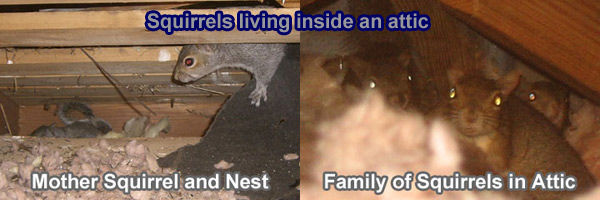
Gray Squirrel Diet: Though life in a forest will afford the squirrel much of what it needs to survive, animals near human dwellings will often raid bird feeders and gardens for more substantial fare. Squirrels hide their food the majority of the time, burying small amounts in multiple locations before cold weather comes. These secret stashes can number in the thousands and are relocated by the squirrel through recall of landmarks near the site. A squirrel will locate the general area of a buried food stash and then use its nose to pinpoint the location. Diet for these animals includes acorns, walnuts, tree bark, seeds, berries, corn, and fungus. If food is scarce, a squirrel may eat insects or bird eggs. Because a diet consisting mainly of nuts, seeds, and berries is not nutritionally balanced, gray squirrels will chew bones or deer antlers to gain the minerals needed in their diets.
Gray Squirrel Nuisance Concerns: Attics and other less frequented buildings are prime areas for gray squirrels to claim. You will notice scratching sounds first, often during early morning or evening. An attic is warm and dry, quiet and relatively free of predators. A squirrel will create a nest using insulation and other materials used inside the home. Not only are they destructive, gray squirrels leave a variety of messes including feces and food remnants. The chewing done by a nesting squirrel can leave to serious hazards inside the home. Electrical wires, if chewed, may result in a fire. Other nuisance concerns center on outdoor maintenance. People who enjoy wild birds often dislike squirrels in feeders, as squirrels will chase away most species of birds. Squirrels can also wreak havoc on a vegetable garden even when natural food sources are in ready supply.
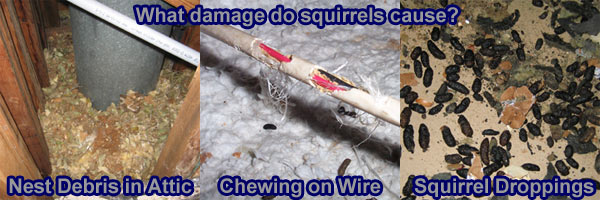
Gray Squirrel Diseases: For humans, the most serious illnesses transmitted by squirrels have to do with the feces left behind. Leptospirosis and salmonella are both deadly diseases carried in squirrel droppings. Squirrels are also vectors for a variety of external parasites which can cause secondary infection in people for diseases such as Lyme disease. All mammals in North America are suspect for rabies, though the frequency of this disease in the squirrel population is occasional.
This site is intended to provide squirrel education and information, so that you can make an informed decision if you need to deal with a squirrel problem. This site provides many squirrel control articles and strategies, if
you wish to attempt to solve the problem yourself. If you are unable to do so, which is likely with many cases of squirrel removal, please go to the home page and click the USA map, where I have wildlife removal experts
listed in over 500 cites and towns, who can properly help you with your nuisance squirrel.
Learn more about squirrels thorugh my educational articles, based on my years of professional experience. Find out if
repellents will get squirrels out of the attic, and the best bait to use to trap a squirrel. Learn how to keep squirrels away from your property as well as some humane ways to kill a squirrel in a cage. I can let you know what you should do with a squirrel after you catch it and if a squirrel with chew through the ceiling. Find out the effectiveness of using repellents to get a squirrel out of a chimney, and exactly how well squirrels can climb and jump. Learn if homeowners insurance will pay for squirrel damage, and if the city or county animal services help with a squirrel issue. I can show you how to find and remove a dead squirrel from the house, and let you know why they Die in Houses and Attics to begin with. Learn about the squirrel's natural diet, what squirrel feces look like, the diseases squirrels carry, and the symptoms of a sick squirrel.
I can show you how to use a one-way funnel to get squirrels out of a building, and some ways to kill a squirrel in the yard. Learn what equipment is needed to trap a squirrel and how squirrels use thier tails. Find out if a high pitch sound deterrent machine will work against squirrels, and how to use a snare pole to catch a squirrel. Find out how smart they are, and what to do about a squirrel in the fire place. I can show you how to get squirrels out of the chimney and what wild life rehabilitators do with squirrels. Read my thoughts on if you should hire a pro or remove a squirrel yourself and what to do about a squirrel under the porch. Learn if you should ever poison a squirrel and how to stop squirres from chewing on your house or plants. Find out if a pest control company will remove a squirrel, and what you should do if you find an orphaned baby squirrel. Learna about squirrel Mating habits andeven if squirrels kill mice, rats or birds.

















